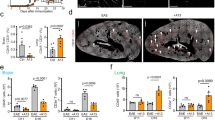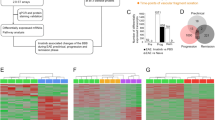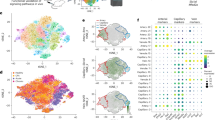Abstract
Specific inhibition of the entry of encephalitogenic T lymphocytes into the central nervous system in multiple sclerosis would provide a means of inhibiting disease without compromising innate immune responses. We show here that targeting lymphocyte interactions with endothelial basement membrane laminins provides such a possibility. In mouse experimental autoimmune encephalomyelitis, T lymphocyte extravasation correlates with sites expressing laminin α4 and small amounts of laminin α5. In mice lacking laminin α4, laminin α5 is ubiquitously expressed along the vascular tree, resulting in marked and selective reduction of T lymphocyte infiltration into the brain and reduced disease susceptibility and severity. Vessel phenotype and immune response were not affected in these mice. Rather, laminin α5 directly inhibited integrin α6β1–mediated migration of T lymphocytes through laminin α4. The data indicate that T lymphocytes use mechanisms distinct from other immune cells to penetrate the endothelial basement membrane barrier, permitting specific targeting of this immune cell population.
This is a preview of subscription content, access via your institution
Access options
Subscribe to this journal
Receive 12 print issues and online access
$209.00 per year
only $17.42 per issue
Buy this article
- Purchase on SpringerLink
- Instant access to full article PDF
Prices may be subject to local taxes which are calculated during checkout






Similar content being viewed by others

References
Ohashi, K.L., Tung, D.K., Wilson, J., Zweifach, B.W. & Schmid-Schonbein, G.W. Transvascular and interstitial migration of neutrophils in rat mesentery. Microcirculation 3, 199–210 (1996).
Hoshi, O. & Ushiki, T. Neutrophil extravasation in rat mesenteric venules induced by the chemotactic peptide N-formyl-methionyl-luecylphenylalanine (fMLP), with special attention to a barrier function of the vascular basal lamina for neutrophil migration. Arch. Histol. Cytol. 67, 107–114 (2004).
Yadav, R., Larbi, K.Y., Young, R.E. & Nourshargh, S. Migration of leukocytes through the vessel wall and beyond. Thromb. Haemost. 90, 598–606 (2003).
Bixel, M.G. et al. A CD99-related antigen on endothelial cells mediates neutrophil but not lymphocyte extravasation in vivo. Blood 109, 5327–5336 (2007).
Hallmann, R. et al. Expression and function of laminins in the embryonic and mature vasculature. Physiol. Rev. 85, 979–1000 (2005).
Engelhardt, B. Lymphocyte trafficking through the central nervous system. in Adhesion Molecules and Chemokines in Lymphocyte Trafficking (ed. Hamann, A.) 173–200 (Harwood Academic Publishers, Amsterdam, 1997).
Sixt, M. et al. Endothelial cell laminin isoforms, laminin 8 and 10, play decisive roles in in T-cell recruitment across the blood-brain-barrier in an experimental autoimmune encephalitis model (EAE). J. Cell Biol. 153, 933–946 (2001).
Agrawal, S. et al. Dystroglycan is selectively cleaved at the parenchymal basement membrane at sites of leukocyte extravasation in experimental autoimmune encephalomyelitis. J. Exp. Med. 203, 1007–1019 (2006).
Kawakami, N. et al. Live imaging of effector cell trafficking and autoantigen recognition within the unfolding autoimmune encephalomyelitis lesion. J. Exp. Med. 201, 1805–1814 (2005).
Wang, S. et al. Venular basement membranes contain specific matrix protein low expression regions that act as exit points for emigrating neutrophils. J. Exp. Med. 203, 1519–1532 (2006).
Reese, T.S. & Karnovsky, M.J. Fine structural localization of a blood-brain barrier to exogenous peroxidase. J. Cell Biol. 34, 207–217 (1967).
Toft-Hansen, H. et al. Metalloproteinases control brain inflammation induced by pertussis toxin in mice overexpressing the chemokine CCL2 in the central nervous system. J. Immunol. 177, 7242–7249 (2006).
Kerfoot, S.M. & Kubes, P. Overlapping roles of P-selectin and α4 integrin to recruit leukocytes to the central nervous system in experimental autoimmune encephalomyelitis. J. Immunol. 169, 1000–1006 (2002).
Vajkoczy, P., Laschinger, M. & Engelhardt, B. α4-integrin–VCAM-1 binding mediates G protein–independent capture of encephalitogenic T cell blasts to CNS white matter microvessels. J. Clin. Invest. 108, 557–565 (2001).
Engelhardt, B. Molecular mechanisms involved in T cell migration across the blood-brain barrier. J. Neural Transm. 113, 477–485 (2006).
Alt, C., Laschinger, M. & Engelhardt, B. Functional expression of the lymphoid chemokines CCL19 (ELC) and CCL 21 (SLC) at the blood-brain barrier suggests their involvement in G-protein–dependent lymphocyte recruitment into the central nervous system during experimental autoimmune encephalomyelitis. Eur. J. Immunol. 32, 2133–2144 (2002).
Babcock, A.A., Kuziel, W.A., Rivest, S. & Owens, T. Chemokine expression by glial cells directs leukocytes to sites of axonal injury in the CNS. J. Neurosci. 23, 7922–7930 (2003).
Glabinski, A.R., Tani, M., Tuohy, V.K., Tuthill, R.J. & Ransohoff, R.M. Central nervous system chemokine mRNA accumulation follows initial leukocyte entry at the onset of acute murine experimental autoimmune encephalomyelitis. Brain Behav. Immun. 9, 315–330 (1995).
Geberhiwot, T. et al. Laminin-8 (α4β1γ1) is synthesized by lymphoid cells, promotes lymphocyte migration and costimulates T cell proliferation. J. Cell Sci. 114, 423–433 (2001).
Gorfu, G. et al. Laminin isoforms of lymph nodes and predominant role of α5-laminin(s) in adhesion and migration of blood lymphocytes. J. Leukoc. Biol. 84, 701–712 (2008).
Thyboll, J. et al. Deletion of the laminin α4 chain leads to impaired microvessel maturation. Mol. Cell. Biol. 22, 1194–1202 (2002).
Frieser, M. et al. Cloning of the mouse laminin α4 gene: expression in a subset of endothelium. Eur. J. Biochem. 246, 727–735 (1997).
Bai, X.F. et al. CD24 controls expansion and persistence of autoreactive T cells in the central nervous system during experimental autoimmune encephalomyelitis. J. Exp. Med. 200, 447–458 (2004).
Flügel, A. et al. Migratory activity and functional changes of green fluorescent effector cells before and during experimental autoimmune encephalomyelitis. Immunity 14, 547–560 (2001).
Gimond, C. et al. Cre-loxP–mediated inactivation of the α6A integrin spliced variant in vivo: evidence for a specific functional role of α6A in lymphocyte migration but not in heart development. J. Cell Biol. 143, 253–266 (1998).
Georges-Labouesse, E. et al. Absence of integrin α6 leads to epidermolysis bullosa and neonatal death in mice. Nat. Genet. 13, 370–373 (1996).
Thompson, R.D. et al. Platelet-endothelial cell adhesion molecule-1 (PECAM-1)-deficient mice demonstrate a transient and cytokine-specific role for PECAM-1 in leukocyte migration through the perivascular basement membrane. Blood 97, 1854–1860 (2001).
Wakelin, M.W. et al. An anti–platelet-endothelial cell adhesion molecule-1 antibody inhibits leukocyte extravasation from mesenteric microvessels in vivo by blocking the passage through the basement membrane. J. Exp. Med. 184, 229–239 (1996).
Patton, B.L. et al. Properly formed but improperly localized synaptic specializations in the absence of laminin α4. Nat. Neurosci. 4, 597–604 (2001).
Wang, J. et al. Cardiomyopathy associated with microcirculation dysfunction in laminin α4 chain–deficient mice. J. Biol. Chem. 281, 213–220 (2006).
Colognato, H. & Yurchenco, P.D. Form and function: the laminin family of heterotrimers. Dev. Dyn. 218, 213–234 (2000).
Yurchenco, P.D., Smirnov, S. & Mathus, T. Analysis of basement membrane self-assembly and cellular interactions with native and recombinant glycoproteins. Methods Cell Biol. 69, 111–144 (2002).
Galea, I. et al. An antigen-specific pathway for CD8 T cells across the blood-brain barrier. J. Exp. Med. 204, 2023–2030 (2007).
Fujiwara, H., Kikkawa, Y., Sanzen, N. & Sekiguchi, K. Purification and characterization of human laminin-8. Laminin-8 stimulates cell adhesion and migration through α3β1 and α6β1 integrins. J. Biol. Chem. 276, 17550–17558 (2001).
Fujiwara, H., Gu, J. & Sekiguchi, K. Rac regulates integrin-mediated endothelial cell adhesion and migration on laminin-8. Exp. Cell Res. 292, 67–77 (2004).
Greter, M. et al. Dendritic cells permit immune invasion of the CNS in an animal model of multiple sclerosis. Nat. Med. 11, 328–334 (2005).
Engelhardt, B. The blood-central nervous system barriers actively control immune cell entry into the central nervous system. Curr. Pharm. Des. 14, 1555–1565 (2008).
Nasdala, I. et al. A transmembrane tight junction protein selectively expressed on endothelial cells and platelets. J. Biol. Chem. 277, 16294–16303 (2002).
Rehder, D. et al. Junctional adhesion molecule-a participates in the formation of apico-basal polarity through different domains. Exp. Cell Res. 312, 3389–3403 (2006).
Sorokin, L.M. et al. Developmental regulation of laminin α 5 suggests a role in epithelial and endothelial cell maturation. Dev. Biol. 189, 285–300 (1997).
Ford, A.L., Goodsall, A., Hickey, W. & Sedgwick, J. Normal adult ramified microglia separated from other CNS macrophages by flow cytometric sorting. J. Immunol. 154, 4309–4321 (1995).
Sixt, M., Hallmann, R., Wendler, O., Scharffetter-Kochanek, K. & Sorokin, L.M. Cell adhesion and migration properties of β2-integrin negative, polymorphonuclear granulocytes (PMN) on defined extracellular matrix molecules: relevance for leukocyte extravasation. J. Biol. Chem. 276, 18878–18887 (2001).
Acknowledgements
This work was supported by the German (SFB293 A14, B8, A1; SFB492 Z3) and Swedish Research Councils (K2005-06X-14184-04A, 621-2001-2142), Alfred Österlunds Foundation, Knut and Alice Wallenbergs Foundation (KAW 2002.0056), the Crafoord Foundation, the Greta and Johan Kocks Foundation and the Interdisciplinary Clinical Research Center (IZKF; Lo2/017/07) in Münster, Germany. We thank M. Sixt for initial studies on Lama4−/− mice, J. Eble (Frankfurt University) for recombinant integrin α6β1, A. Sonnenberg (Division of Cell Biology, The Netherlands Cancer Institute) for GoH3, A. De Arcangelis for tissue collection, G. Roos for technical assistance and F. Kiefer and R. Böhmer for assistance with confocal microscopy.
Author information
Authors and Affiliations
Contributions
All experimental work was carried out by C.W. P.A. and F.I. contributed to the in vivo and in vitro T lymphocyte proliferation studies; P.N. was instrumental in generation of bone marrow–chimeric mice; H.R. carried out all electron microscopy studies; the Lama4−/− mouse was generated in K.T.'s laboratory; R.H. was instrumental in project development and experimental design; D.V. provided expertise and tools for assessment of endothelial cell-to-cell contacts in Lama4−/− mice; K.L., S.B. and J.S. provided expertise and tools for FACS analyses; E.K. carried out immunofluorescence analyses; E.G.-L. provided the Itga6−/− embryonic liver cells for generation of bone marrow–chimeric mice; project development and all experimental work was carried out under the supervision and in the laboratory of L.M.S.
Corresponding author
Supplementary information
Supplementary Text and Figures
Supplementary Figs. 1–5 and Supplementary Methods (PDF 5107 kb)
Supplementary Video 1
Quick time movie of 0.4-μm Z stacks through a portion of the 60-μm section of WT mouse brain double-stained for laminin α4 (green) and laminin α5 (red) shown in Figure 1a. (MOV 2363 kb)
Supplementary Video 2
Quick time movie of 0.4-μm Z stacks through a portion of the 60-μm section of WT EAE brain double-stained for laminin α5 (green) and CD45 (red) shown in Figure 1b. (MOV 4141 kb)
Rights and permissions
About this article
Cite this article
Wu, C., Ivars, F., Anderson, P. et al. Endothelial basement membrane laminin α5 selectively inhibits T lymphocyte extravasation into the brain. Nat Med 15, 519–527 (2009). https://doi.org/10.1038/nm.1957
Received:
Accepted:
Published:
Issue Date:
DOI: https://doi.org/10.1038/nm.1957
This article is cited by
-
Endothelial and mural laminin-α5 contributes to neurovascular integrity maintenance
Fluids and Barriers of the CNS (2024)
-
The niche matters: origin, function and fate of CNS-associated macrophages during health and disease
Acta Neuropathologica (2024)
-
The origin of brain malignancies at the blood–brain barrier
Cellular and Molecular Life Sciences (2023)
-
Blood–brain barrier: emerging trends on transport models and new-age strategies for therapeutics intervention against neurological disorders
Molecular Brain (2022)
-
The impact of genetic manipulation of laminin and integrins at the blood–brain barrier
Fluids and Barriers of the CNS (2022)


